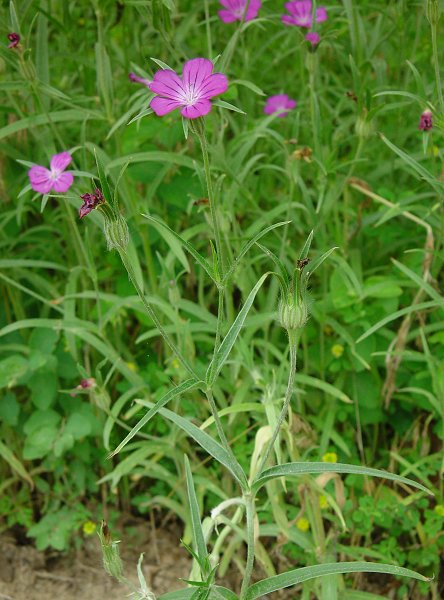Agrostemma githago L.
Corn Cockle

Introduced
CC = *
CW = 5
MOC = 36
© DETenaglia
Agrostemma githago L.Corn Cockle | |
 |
Introduced CC = * CW = 5 MOC = 36 |
© DETenaglia |
|
Family - Caryophyllaceae Habit - Annual forb. Stems - Erect, to 1 m, sometimes branched, densely pubescent with white hairs. Nodes swollen.
Leaves - Opposite, simple, sessile, with bases fused and sheathing stem. Blades to 15 cm, linear to narrowly lanceolate, sharply pointed, entire, densely hairy.
Inflorescences - Mostly solitary flowers at branch tips, on stalks to 20 cm. Bracts leaflike, reduced. Flowers - Sepals 5, 2-6 cm long, fused basally into a tube 10-17 mm long, this densely hairy, 10-nerved, the lobes linear or linear-lanceolate, sharply pointed at the tip, the margins green and herbaceous. Petals 5, conspicuous and showy, 15-40 mm long, oblanceolate to spatulate, entire or shallowly notched at the tip, purplish red or pink. Stamens 10. Staminodes absent. Pistil with 1 locule, sessile. Styles 5, each with a subterminal stigmatic area.
Fruits - Capsules, 16-24 mm long, dehiscing apically by 5 ascending teeth. Seeds mostly 30-60, 3-4 mm wide, kidney-shaped, the surface tuberculate, black. Flowering - May - September. Habitat - Fallow and cultivated fields, waste ground, roadsides, railroads. Origin - Native to Europe. Lookalikes - None. Other info. - This species can be found in scattered locations in Missouri, mostly in the southeastern half of the state, and sporadically throughout much of the U.S. It is easy to ID in the field due to its sericeous stems and leaves and its showy, bright pinkish flowers. It is an introduced plant which favors sandy soils. In the past it has been a common crop weed, but better seed handling and application of herbicides have reduced this occurrence, and in fact the plant's populations in the U.S. have been declining. It is occasionally cultivated as an ornamental due to its beautiful flowers. The plant's large seeds contain steroidal saponins and are toxic to birds and livestock. Photographs taken in the Ozark Scenic Riverways, Shannon County, MO., 5-24-03 (DETenaglia); also at Sand Pond Conservation Area, Ripley County, MO, 5-19-2014 (SRTurner). |